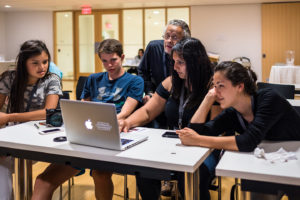Since our last workshop to Hyderabad, we’ve implemented a new format for our Advanced class. For some time, we’ve felt the need to go further and do more that was outside of the limitations of our beginning class. First, in most cases we’re starting from scratch and getting all of the students up to speed on the basics of photography…that in itself leaves little time for much else. The second thing we want our kids to walk away with is the skill of how to finish a professional job that is deeply technical and involved. Now clearly there is NO WAY we could do this all in the eight days we have for the beginner class: there is just too much to cover. But in India this year, we may have finally nailed down the format that best fits the needs of the students and allows us to accomplish all of our learning goals.

When a photographer goes out to shoot a job, there is a lot to consider. The subject matter, environment, and the client will determine the photographers approach and type of equipment needed. They’ll have to manage the logistics, guide and pose the subjects, and be sure to be in the right place at the right time to get the shot. However, it’s often after the “photo shoot” that he or she begins all of the technical work needed for post-production. All of the photos need to be downloaded and backed up, the best images need to be culled from the myriad of extra “almost there” shots, they need to be developed (adjusted for brightness/contrast, color saturation, white balance, and sharpness), and they need to be exported to a format that is usable by the client.
 By the end of these three days our advanced students will need to have the skills to do all of this and be self-sufficient. To accomplish this, we use Adobe’s program Lightroom as our working environment. It has a suite of capabilities that allow us to not only catalog and keyword our work so they stay organized, to develop those images using the Photoshop image engine, and to design and output our images to a number of mediums: print, web, and audio visual. It’s powerful and user friendly but for everything there is a learning curve.
By the end of these three days our advanced students will need to have the skills to do all of this and be self-sufficient. To accomplish this, we use Adobe’s program Lightroom as our working environment. It has a suite of capabilities that allow us to not only catalog and keyword our work so they stay organized, to develop those images using the Photoshop image engine, and to design and output our images to a number of mediums: print, web, and audio visual. It’s powerful and user friendly but for everything there is a learning curve.
We spent the day today working through the process of post-production. We reviewed archiving practices and began toying with the tools for photo developing. In addition to the technical, we began working with the students on the more abstract ideas of editing a series of images and sequencing them in to an order that conveys a story. We introduced this idea to them by watching a brilliant series of slideshows from the New York Times. We also edited images together in a large group, and then we gave them time to practice on their own. They went out and shot a practice series of images to run through this workflow process. They had time to practice in small groups and at the end of the day without instructors. We gave a tight deadline and kept the pressure high in order to get them working together and moving forward. We were excited that they did so great with a deadline! Everyone did great! Two of the four groups finished just a few of the minutes past their deadlines. As an end to the day we watched their practice slideshows and gave some feedback before calling it a night.
Tomorrow’s going to be a busy day!
2 Comments, RSS